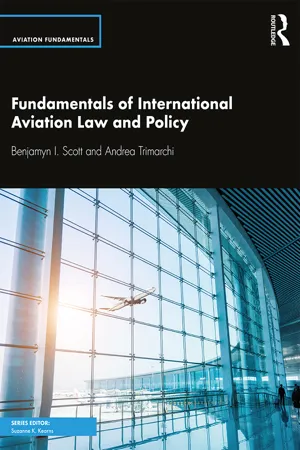![]()
CHAPTER 1
Foundations of
Aviation Law
LEARNING OBJECTIVES
• List the different sources of international aviation law.
• Distinguish between public and private international aviation law.
• Identify the key legal areas of study in international aviation law.
• Know the basic definitions and terms used in international aviation law.
• Identify the different aviation stakeholders.
1.1 Introduction
1.1.1 Aviation v. Air Law
There are two prevailing terms used to name this area of study:
• Air Law
• Aviation Law
If the term ‘aviation’ is consulted in the dictionary, it can be defined as “[t]he flying or operating of aircraft”.1 Thus, the focus is on the activity – the operation of aircraft. Alternatively, the term ‘air’ corresponds to the “invisible gaseous substance surrounding the earth, a mixture mainly of oxygen and nitrogen.”2 The focus is the geographical location in which the activities are taking place. The differences in the ordinary meaning of these words suggest that the terms ‘aviation law’ and ‘air law’ correspond to different fields of study.
Did You Know?
The use of terminology used to label the field of law is not unique to aviation. For example, the law governing the use of the seas and oceans is called either ‘maritime law’ or ‘law of the sea’. However, these terms are used to denote different content. Generally, ‘maritime law’ is used for national law and ‘law of the sea’ is the body of international rules.
However, while this may be the case linguistically, in practice, this distinction is often over-looked as the two terms are used interchangeably in the literature to correspond to the same area of law. To provide consistency between this book and the rest of the books in this series, the term ‘aviation’ has been adopted.3
1.1.2 What is Aviation Law?
Before beginning an introductory study of aviation law, the scope of the topic must be defined. This will stop the book from drifting off course into unrelated areas and will, on the other hand, prevent fundamental themes from being overlooked that are vital for the successful study of this area of law.
The development of aviation law could have taken place in two ways:
• Option 1: Introduce aviation related content into existing legal instruments.
• Option 2: Create a sui generis legal regime consisting of distinct and specialised rules for aviation.
Depending on how aviation law is defined, elements of both options can be found. For example, aircraft insurance is generally handled through insurance contracts tailored to the subject matter and are governed by national contract and insurance law.4 Whereas, aviation safety is generally regulated via specific instruments unique to the subject material.
This then leads to the next hurdle in trying to define aviation law. There are three competing theories as to what aviation law is.
Table 1.1 Theories on aviation law
| Existing | Separate | Autonomous |
| Aviation law is simply a part of existing larger divisions of law, such as contract, criminal and tort, which concern aviation stakeholders. | Aviation law is separate from other areas of law and stands by itself. | Whatever its origins (Existing or Separate), aviation law has evolved into an autonomous body of law that allows for the production of new laws. |
Depending on the definition, elements of all three can be identified. This is because aviation law can be defined in a way that fits the users’ purpose; it is malleable.
For the purpose of this book, aviation law is used in a broad way to include rules, whether international or national, that have as their object or subject, stakeholders involved in aviation transport. Stakeholders can include different natural and legal persons, such as:
• Aerodromes/Airports
• Aircrew
• Airlines
• Air Navigation Providers/Air Traffic Controllers
• General Aviation (Private Non-Commercial)
• Ground Handling
• International Governmental Organisations
• International Non-Governmental Organisations
• Manufacturers
• Members of the Public
• Passengers
• States5
• Tour Operators
• Training Organisations
This is a non-exhaustive list and could include other stakeholders depending on the context. Throughout the book, elements of the three theories will be evident.
1.2 Key Elements in Aviation Law
This book focuses on international aviation law. As international aviation “is an international activity regulated by a combination of public and private international law”,6 it is therefore important to distinguish between the two areas (public and private).
Definitions
International: The term ‘international’ features in different aviation conventions and has a specific meaning for each body of law. Therefore, caution must be given when using this term. When using the term outside the context of a specific convention, this book uses it to refer to activities between more than one State.
Public international law is the collection of rules that legally binds a State in its interaction with other States. With the evolution of public international law, the traditional State-to-State scope has been broadened and new entrants can include individuals and international organisations.
Traditionally, public international aviation law involves:
• Sovereignty (including Transit and Traffic Rights)
• Safety (including Accident Investigation and Incident Reporting)
• Security
• Criminal
• Environment
• Competition Rules
Public international law is to be distinguished from private international law. The latter is sometimes called the ‘conflict of laws’ as it determines:
the applicability of a certain law or certain rules of law in situations involving a choice between the laws of different countries. In this context, the term international does not refer to the internationality of the source of law but to the internat...
